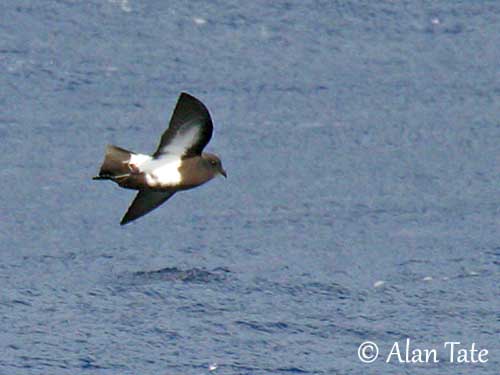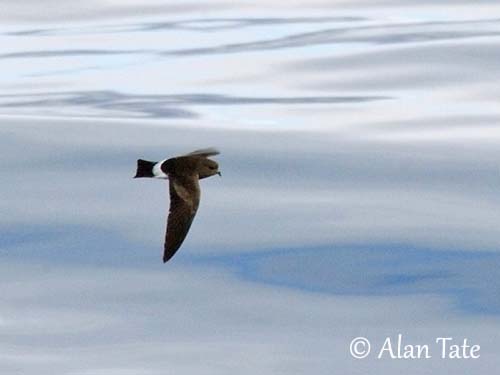
Fr: Océanite à ventre noir
Ang: Black-bellied Storm-Petrel
All: Schwarzbauch-Sturmschwalbe
Esp: Paíño Ventrinegro
Ita: Uccello delle tempeste ventrenero
Nd: Zwartbuikstormvogeltje
Sd: Svartmagad stormsvala
Photographers:
Simon Tan
PBase Bird galleries
Alan & Ann Tate
AA Bird Photography
Text by Nicole Bouglouan
Sources:
HANDBOOK OF THE BIRDS OF THE WORLD vol 1 by Josep del Hoyo-Andrew Elliot-Jordi Sargatal - Lynx Edicions - ISBN: 8487334105
A Complete Guide to Antarctic Wildlife by Hadoram Shirihai and Illustrated by Brett Jarrett - Edited by Guy M. Kirwan - ALUL.A Press Oy, Finland - ISBN 9519894705
BirdLife International (BirdLife International)
Australian Antarctic Division: Leading Australia's Antarctic Program
New Zealand birds and birding (Narena Olliver)
Ocean Wanderers "Ride the Wave"
Neotropical Birds – Cornell Lab of Ornithology
Black-bellied Storm-Petrel
Fregetta tropica
Procellariiformes Order – Oceanitidae Family
INTRODUCTION:
The Black-bellied Storm-Petrel occurs throughout the Southern Ocean and breeds on several subantarctic islands. As it prefers cold waters, it is a true subantarctic breeder.
The genus Fregetta includes two main species, but actually, there are six distinct forms. They belong now to the Southern family Oceanitidae that shows a great taxonomy diversity.
This species is threatened by invasive and introduced predators to their breeding islands.
DESCRIPTION OF THE BIRD:
Biometrics:
Length: 20 cm
Wingspan: 43-46 cm
Weight: 43-63 g
The adult has rather compact body with rounded wings and short, square-tipped tail.
Head, neck, breast and upperparts including wings and tail, are blackish-brown, whereas rump and belly are white. Black vent and central belly stripe are variable. This stripe connects the blackish throat and breast to vent and undertail-coverts. On the underwing, flight feathers and leading edge are blackish, whereas the underwing-coverts are white in the centre of the wing. On the upperwing, the coverts are browner than the blackish flight feathers. We can see some pale fringes to scapulars and tips of greater coverts, forming an indistinct panel even in fresh plumage. The undertail is blackish.
The bill is black and hooked at tip. The long, tubular, external nostrils might allow the bird to detect food by smell. The eyes are dark brown. Legs and webbed feet are black.
Both adults are similar although the female has slightly larger wings, tail and tarsus.
The juvenile resembles adult.

SUBSPECIES AND RANGE:
The Black-bellied Storm-Petrel has two subspecies.
F.t. tropica (described and displayed) is found from islands of Scotia Arc, through South Indian Ocean to Antipodes Islands.
F.t. melanoleuca occurs on Tristan da Cunha and Gough Island. This race has sometimes partially white or all-white central belly.
However, this subspecies may be invalid or referable to F. grallaria (White-bellied Storm-Petrel).
HABITAT:
The Black-bellied Storm-Petrel is highly pelagic and feeds close to or beyond the continental shelf. It breeds on subantarctic islands or stacks, on bare rocky slopes or in dense vegetation and even in peat where it can dig the burrow.
CALLS AND SONGS: SOUNDS BY XENO-CANTO
The Black-bellied Storm-Petrel is silent at sea, but at colonies, it gives high-pitched whistle “huuuuu” or softer series of repeated “pip-pip-pip-pip”. On the ground, the bird utters a drawn-out shrill whistle.

BEHAVIOUR IN THE WILD:
The Black-bellied Storm-Petrel feeds on crustaceans, squid and small fish. Most crustaceans are of genus Euphausia.
It feeds on wing by pattering, and performs dipping and surface-seizing, and shallow plunges from the air.
It also forages in association with killer whales and other large cetaceans. According to the range, it can be seen around the longline trawlers, especially in S Indian Ocean, but it rarely follows the ships.
It is usually solitary, but sometimes, they may gather into small groups. Most feeding is probably nocturnal.
The Black-bellied Storm-Petrel breeds in colonies where it is wholly nocturnal. Both mates are monogamous with long-term pair-bonds. The pair may sometimes return to the same burrow. They are territorial around the entrance. When they are threatened, they eject the contents of their stomachs onto intruders or predators. This substance is produced by the adults during the period of chick rearing.
The Black-bellied Storm-Petrel is vulnerable to predation, especially by skuas and owls, as it emerges from the burrow.

The courtship displays consist of aerial pursuits. Two or more birds fly fast in circles above the nesting site while calling loudly. However, most of the sexual activity takes place inside the burrow. They perform mutual preening and bill-touching. The copulation occurs inside the nest-chamber.
The Black-bellied Storm-Petrel migrates N after breeding, into tropical and subtropical zones of Atlantic, Indian and Pacific Oceans.
It is an agile flier with buoyant and erratic flight. It usually flies low over the water, gliding slowly with dangling legs, and dipping the feet in the water. The bird appears like walking on the water!

REPRODUCTION OF THIS SPECIES:
The egg-laying occurs between December and February. The Black-bellied Storm-Petrel breeds in loose colonies among broken rocks or in excavated burrows in soft soil and peat.
The female lays a single white egg with small spots at the broad end. This egg is large in relation to the size of the adults. Both parents share the incubation during 35-44 days in shifts of 1-6/3-7 days.
At hatching, the chick has pale grey down. It is fed once/day by its parents. It fledges between 65 and 71 days after hatching.
PROTECTION / THREATS / STATUS:
The Black-bellied Storm-Petrel is widespread in its range. The global population was estimated at about 500,000 individuals in 2004. Some declines are suspected, due to predation by invasive and introduced mammals such as mice, rats and cats, but also by natural avian predators including skuas and owls.
The Black-bellied Storm-Petrel is currently evaluated as Least Concern.
